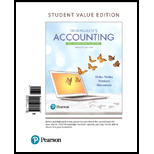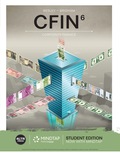
Horngren's Accounting: The Managerial Chapters, Student Value Edition (12th Edition)
12th Edition
ISBN: 9780134491509
Author: MILLER-NOBLES, Tracie L., Mattison, Brenda L., Matsumura, Ella Mae
Publisher: PEARSON
expand_more
expand_more
format_list_bulleted
Concept explainers
Textbook Question
Chapter 1, Problem 1.1DC
Decision Case 1-1 Let’s examine a case using Greg's Tunes and Sal's Silly Songs. It is now the end of the first year of operations, and both owners want to know how well each business came out at the end of the year. Neither business kept complete accounting records, and neither owner made any withdrawals. The businesses throw together the data shown below at year-end:
| Sal's Silly Songs: | |
| Total Assets | $ 23,000 |
| Owner contribution | 8,000 |
| Total Revenues | 35,000 |
| Total Expenses | 22,000 |
| Greg's Tunes: | |
| Total Liabilities | $ 10,000 |
| Owner contribution | 6,000 |
| Total Expenses | 44,000 |
| Net Income | 9,000 |
To gain information for evaluating the businesses, the owners ask you several questions. For each answer, you must show your work to convince the owners that you know what you are talking about.
Requirements
- Which business has more assets?
- Which business owes more to creditors?
- Which business has more owner's equity at the end of the year?
- Which business brought in more revenue?
- Which business is more profitable?
- Which of the foregoing questions do you think is most important for evaluating these two businesses? Why?
- Which business looks better from a financial standpoint?
Expert Solution & Answer
Want to see the full answer?
Check out a sample textbook solution
Students have asked these similar questions
A company purchased equipment for $50,000. The equipment has a useful life of 10 years and no salvage value. Which of the following journal entries is correct for recording one year of straight-line depreciation?
A.Debit: Equipment $5,000Credit: Cash $5,000
B.Debit: Depreciation Expense $5,000Credit: Accumulated Depreciation $5,000
C.Debit: Accumulated Depreciation $5,000Credit: Equipment $5,000
D.Debit: Depreciation Expense $50,000Credit: Equipment $50,000Need help
A company purchased equipment for $50,000. The equipment has a useful life of 10 years and no salvage value. Which of the following journal entries is correct for recording one year of straight-line depreciation?
A.Debit: Equipment $5,000Credit: Cash $5,000
B.Debit: Depreciation Expense $5,000Credit: Accumulated Depreciation $5,000
C.Debit: Accumulated Depreciation $5,000Credit: Equipment $5,000
D.Debit: Depreciation Expense $50,000Credit: Equipment $50,000
I need help.
Which of the following transactions would not affect owner’s equity?A. Earning revenueB. Paying rent expenseC. Receiving a loan from the bankD. Paying dividends
Chapter 1 Solutions
Horngren's Accounting: The Managerial Chapters, Student Value Edition (12th Edition)
Ch. 1 - Prob. 1QCCh. 1 - Which of the following is not an external user of...Ch. 1 - Prob. 3QCCh. 1 - Prob. 4QCCh. 1 - Prob. 5QCCh. 1 - Which of the following requires accounting...Ch. 1 - At the end of a recent year, Global Cleaning...Ch. 1 - Consider the overall effects on Global Cleaning...Ch. 1 - Assume that Global Cleaning Service performed...Ch. 1 - The balance sheet reports the Learning Objective 5...
Ch. 1 - Assume Global Cleaning Service had net income of...Ch. 1 - What is accounting?Ch. 1 - Prob. 2RQCh. 1 - Prob. 3RQCh. 1 - Prob. 4RQCh. 1 - Prob. 5RQCh. 1 - Prob. 6RQCh. 1 - Prob. 7RQCh. 1 - A business purchases an acre of land for $5,000....Ch. 1 - What does the going concern assumption mean for a...Ch. 1 - Which concept states that accounting information...Ch. 1 - Financial statements in the United States are...Ch. 1 - Prob. 12RQCh. 1 - What is the accounting equation? Briefly explain...Ch. 1 - What are two ways that equity increases? What are...Ch. 1 - How is net income calculated? Define revenues and...Ch. 1 - What are the steps used when analyzing a business...Ch. 1 - List the four financial statements. Briefly...Ch. 1 - What is the calculation for ROA? Explain what ROA...Ch. 1 - Prob. S1.1SECh. 1 - Determining organizations that govern accounting...Ch. 1 - Identifying types of business organizations...Ch. 1 - Prob. S1.4SECh. 1 - Applying accounting assumptions and principles...Ch. 1 - Prob. S1.6SECh. 1 - Using the accounting equation Learning Objective 3...Ch. 1 - Identifying accounts Learning Objective 3 Consider...Ch. 1 - Prob. S1.9SECh. 1 - Using the accounting equation to analyze...Ch. 1 - Identifying accounts on the financial statements...Ch. 1 - Preparing the income statement Learning Objective...Ch. 1 - Preparing the statement of owner’s equity Learning...Ch. 1 - Prob. S1.14SECh. 1 - Preparing the statement of cash flows Learning...Ch. 1 - Calculating ROA Learning Objective 6 Matured Water...Ch. 1 - Prob. E1.17ECh. 1 - Prob. E1.18ECh. 1 - 1. Accounting equation a. An economic resource...Ch. 1 - Using the accounting equation Learning Objective 3...Ch. 1 - E1-21 Using the accounting equation Learning...Ch. 1 - Using the accounting equation Learning Objective 3...Ch. 1 - Using the accounting equation Learning Objective 3...Ch. 1 - E1-24 Using the accounting equation Learning...Ch. 1 - Using the accounting equation to analyze...Ch. 1 - Using the accounting equation to analyze business...Ch. 1 - Using the accounting equation to analyze business...Ch. 1 - Using the accounting equation to analyze business...Ch. 1 - Using the accounting equation to analyze business...Ch. 1 - Preparing the financial statements Learning...Ch. 1 - Preparing the income statement Learning Objective...Ch. 1 - Prob. E1.32ECh. 1 - Prob. E1.33ECh. 1 - Prob. E1.34ECh. 1 - Preparing the statement of owner’s equity Learning...Ch. 1 - Prob. E1.36ECh. 1 - Prob. E1.37ECh. 1 - Jan. 1 The owner contributed an additional $5,000...Ch. 1 - Calculating Return on Assets Learning Objective 6...Ch. 1 - Using the accounting equation for transaction...Ch. 1 - Prob. P1.41APGACh. 1 - P1-42A Preparing financial statements Learning...Ch. 1 - Preparing financial statements Learning Objective...Ch. 1 - Prob. P1.44APGACh. 1 - Using the accounting equation for transaction...Ch. 1 - Using the accounting equation for transaction...Ch. 1 - Using the accounting equation for transaction...Ch. 1 - Using the accounting equation for transaction...Ch. 1 - Preparing financial statements Presented here are...Ch. 1 - Prob. P1.50BPGBCh. 1 - Prob. P1.51BPGBCh. 1 - Using the accounting equation for transaction...Ch. 1 - Using the accounting equation for transaction...Ch. 1 - Prob. P1.54CTCh. 1 - P1-55 is the first problem in a continuing problem...Ch. 1 - Prob. 1.1TIATCCh. 1 - Decision Case 1-1 Let’s examine a case using...Ch. 1 - The tobacco companies have paid billions because...Ch. 1 - Prob. 1.1FCCh. 1 - Prob. 1.1FSC
Knowledge Booster
Learn more about
Need a deep-dive on the concept behind this application? Look no further. Learn more about this topic, accounting and related others by exploring similar questions and additional content below.Similar questions
- Can you explain this general accounting question using accurate calculation methods?arrow_forwardWhat type of account is Unearned Revenue?A. AssetB. EquityC. LiabilityD. Expensearrow_forwardThe matching principle in accrual accounting requires:A. Revenue to be recorded only when cash is receivedB. Expenses to be recorded when they are paidC. Revenues and related expenses to be recorded in the same periodD. Assets to match with liabilitiesarrow_forward
- The matching principle in accrual accounting requires:A. Revenue to be recorded only when cash is receivedB. Expenses to be recorded when they are paidC. Revenues and related expenses to be recorded in the same periodD. Assets to match with liabilities No Ai .arrow_forwardPlease give correct answer for this question. 10. A classified balance sheet organizes assets and liabilities into:A. Current and non-current categoriesB. Revenue and expense categoriesC. Short-term and income categoriesD. Real and nominal categoriesarrow_forwardWhich of the following transactions would not affect owner’s equity?A. Earning revenueB. Paying rent expenseC. Receiving a loan from the bankD. Paying dividendsarrow_forward
- Which of the following transactions would not affect owner’s equity?A. Earning revenueB. Paying rent expenseC. Receiving a loan from the bankD. Paying dividends No AI pleasearrow_forwardCompute the net income for the year.arrow_forwardI am looking for help with this general accounting question using proper accounting standards.arrow_forward
- i need help in this question with correct approach 9. Which principle requires that expenses be recognized when incurred, regardless of when payment is made?A. Historical Cost PrincipleB. Going Concern PrincipleC. Accrual PrincipleD. Revenue Recognition Principlearrow_forward7. A debit to the Salaries Expense account will:A. Increase total liabilitiesB. Decrease assetsC. Increase expensesD. Increase revenuesarrow_forwardWhich of the following is an example of a permanent account?A. Service RevenueB. Utilities ExpenseC. Retained EarningsD. Dividends No AIarrow_forward
arrow_back_ios
SEE MORE QUESTIONS
arrow_forward_ios
Recommended textbooks for you
 Financial Accounting: The Impact on Decision Make...AccountingISBN:9781305654174Author:Gary A. Porter, Curtis L. NortonPublisher:Cengage Learning
Financial Accounting: The Impact on Decision Make...AccountingISBN:9781305654174Author:Gary A. Porter, Curtis L. NortonPublisher:Cengage Learning College Accounting, Chapters 1-27AccountingISBN:9781337794756Author:HEINTZ, James A.Publisher:Cengage Learning,
College Accounting, Chapters 1-27AccountingISBN:9781337794756Author:HEINTZ, James A.Publisher:Cengage Learning,

Financial Accounting: The Impact on Decision Make...
Accounting
ISBN:9781305654174
Author:Gary A. Porter, Curtis L. Norton
Publisher:Cengage Learning

College Accounting, Chapters 1-27
Accounting
ISBN:9781337794756
Author:HEINTZ, James A.
Publisher:Cengage Learning,


The accounting cycle; Author: Alanis Business academy;https://www.youtube.com/watch?v=XTspj8CtzPk;License: Standard YouTube License, CC-BY